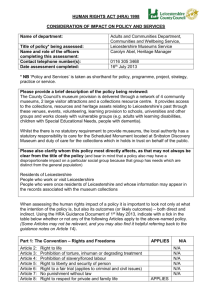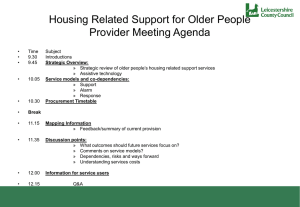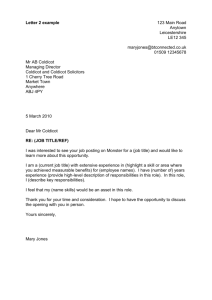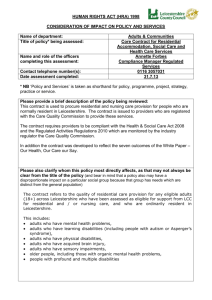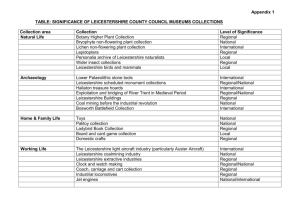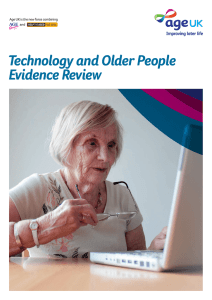human rights act (hra) 1988 - Leicestershire County Council
advertisement
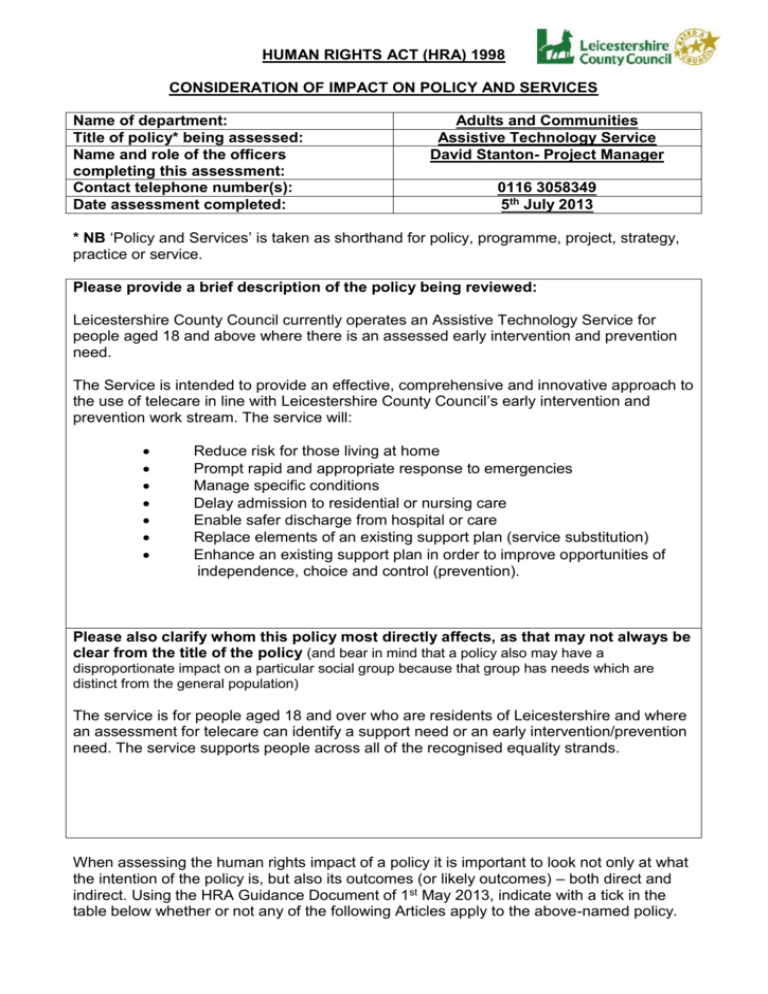
HUMAN RIGHTS ACT (HRA) 1998 CONSIDERATION OF IMPACT ON POLICY AND SERVICES Name of department: Title of policy* being assessed: Name and role of the officers completing this assessment: Contact telephone number(s): Date assessment completed: Adults and Communities Assistive Technology Service David Stanton- Project Manager 0116 3058349 5th July 2013 * NB ‘Policy and Services’ is taken as shorthand for policy, programme, project, strategy, practice or service. Please provide a brief description of the policy being reviewed: Leicestershire County Council currently operates an Assistive Technology Service for people aged 18 and above where there is an assessed early intervention and prevention need. The Service is intended to provide an effective, comprehensive and innovative approach to the use of telecare in line with Leicestershire County Council’s early intervention and prevention work stream. The service will: Reduce risk for those living at home Prompt rapid and appropriate response to emergencies Manage specific conditions Delay admission to residential or nursing care Enable safer discharge from hospital or care Replace elements of an existing support plan (service substitution) Enhance an existing support plan in order to improve opportunities of independence, choice and control (prevention). Please also clarify whom this policy most directly affects, as that may not always be clear from the title of the policy (and bear in mind that a policy also may have a disproportionate impact on a particular social group because that group has needs which are distinct from the general population) The service is for people aged 18 and over who are residents of Leicestershire and where an assessment for telecare can identify a support need or an early intervention/prevention need. The service supports people across all of the recognised equality strands. When assessing the human rights impact of a policy it is important to look not only at what the intention of the policy is, but also its outcomes (or likely outcomes) – both direct and indirect. Using the HRA Guidance Document of 1st May 2013, indicate with a tick in the table below whether or not any of the following Articles apply to the above-named policy. (Some Articles may not be relevant, and you may also find it helpful referring back to the guidance notes on Article 14). Part 1: The Convention – Rights and Freedoms Article 2: Right to life Article 3: Prohibition of torture, inhuman or degrading treatment Article 4: Prohibition of slavery/forced labour Article 5: Right to liberty and security of person Article 6: Right to a fair trial (applies to criminal and civil issues) Article 7: No punishment without law Article 8: Right to respect for private and family life Article 9: Freedom of thought, conscience and religion Article 10: Freedom of expression Article 11: Freedom of assembly and association Article 12: Right to marry Article 14: Prohibition of discrimination (linked to convention rights) Part 2: The First Protocol APPLIES N/A APPLIES Article 1: Protection of property/peaceful enjoyment Article 2: Right to education and out-of-school children Article 3: Right to free elections N/A Please state whether there are any current references in the policy (providing the text or a brief summary) and to which Article(s) the references apply: Article(s) Current HRA references contained in relevant documents Please state why you consider that any particular Article does or may apply to the abovenamed policy: Article(s) 5 Reasons for applicability AT support may be provided for people who lack capacity to make informed choice about technology used as part of their support plan. For example, someone with a dementia condition who engages in purposeful walking (leaving their home accommodation) and who is assessed as being at risk as a result of doing so, may be supported with Door exit sensors, Bed/chair sensors, PIR Sensors and GPS tracking technology. In such cases, the County Council must follow existing protocols and procedures around mental capacity assessment and best interest decision making. In all cases, the least intrusive solution must be provided. Ref. GPS Protocol for staff; Ethical use of telecare (2010). 8 -An assessment of need in relation to Assistive technology will include accessing and handling of a range of personal information relating to individual service users. All such information must be appropriately managed under Leicestershire County Council policy and procedure concerning data protection and information governance. -Assistive technology may include a range of peripheral sensors which monitor an individual’s movements (or lack of) within their own home. This should always be undertaken with the service users knowledge, understanding and agreement or where a mental capacity assessment has concluded with a best interest decision. Ref. Just Checking protocol for staff. The guiding principles in relation to the appropriate use of Telecare are informed by the four principles of: 14 Non Malfeasance (which means “do no harm”) Beneficence (striving consciously to be “of benefit” to the person) Autonomy (respecting the person’s rights to self-determination, freedom, privacy and choice) Justice (treating everyone fairly, taking into account diversity and individual differences.) The Assistive technology service provides support for people aged 18 and above with an early intervention and prevention need. The service is provided to people in Leicestershire across all of the recognised equality strands. The service must ensure that promotion, assessment and support solutions take appropriate account of individual needs and are provided in a nondiscriminatory manner in line with Leicestershire County Council policy and procedure. What text/guidance/information might you be able to add to the policy to begin to address Human Rights Act implications? Article(s) Possible additional text/guidance/information Please set out what else you consider needs to be done to address Human Rights Act implications for the policy:
